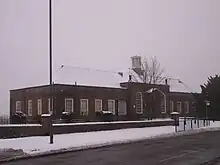52°59′27″N 1°59′13″W / 52.99075°N 1.98705°W
| Cheadle Rural District | |
|---|---|
| Rural district | |
 Council Offices, 40 Leek Road, Cheadle | |
| Population | |
| • 1901[1] | 24,657 |
| • 1971[2] | 40,098 |
| History | |
| • Created | 28 December 1894 |
| • Abolished | 31 March 1974 |
| • Succeeded by | Staffordshire Moorlands |
| Status | Rural district |
| • HQ | Cheadle |
Cheadle Rural District was a rural district in the administrative county of Staffordshire, England from 1894 to 1974, covering an area in the north of the county centred on the small town of Cheadle.
Origins
The district had its origins in the Cheadle Poor Law Union, which had been created in 1837, covering Cheadle itself and several surrounding parishes. In 1872 sanitary districts were established, giving public health and local government responsibilities for rural areas to the existing boards of guardians of poor law unions. The Cheadle Rural Sanitary District was administered from Cheadle Union Workhouse, which had been built in 1775 on Bank Street.[3]
Under the Local Government Act 1894, rural sanitary districts became rural districts from 28 December 1894.[4] The district boundaries were adjusted in 1934 when the neighbouring Mayfield Rural District was abolished and there were other changes to the boundaries with neighbouring districts.[5]
Parishes
The district's civil parishes were:[5]
- Alton
- Blore with Swinscoe (after 1934)
- Bradley in the Moors (until 1934)
- Cauldon (until 1934)
- Caverswall
- Cheadle
- Checkley
- Cheddleton
- Consall
- Cotton
- Denstone (until 1934)
- Dilhorne
- Draycott in the Moors
- Farley
- Forsbrook[lower-alpha 1]
- Ipstones
- Kingsley
- Oakamoor[lower-alpha 2]
- Waterhouses[lower-alpha 3]
Premises
In the early years the council met at the board room of the workhouse, reflecting its origins in the poor law union.[6] The council later built itself a new headquarters at 40 Leek Road (then also known as Greenhill), which was formally opened on 5 March 1937.[7]
Abolition
Cheadle Rural District was abolished under the Local Government Act 1972, merging with the Leek Rural District and the urban districts of Biddulph and Leek to become the new district of Staffordshire Moorlands.[8] The former Cheadle Rural District Council offices at 40 Leek Road subsequently served as an area office for the new district council until being sold and converted into flats around 2015, with the old council chamber being retained in municipal use for meetings of Cheadle Town Council.[9][10]
References
- ↑ "Cheadle Rural District: Population". A Vision of Britain through Time. GB Historical GIS / University of Portsmouth. Retrieved 31 December 2023.
- ↑ "1971 Census of England and Wales, County Report Part I". A Vision of Britain through Time. GB Historical GIS / University of Portsmouth. Retrieved 31 December 2023.
- ↑ Higginbotham, Peter. "Cheadle Workhouse". The Workhouse. Retrieved 31 December 2023.
- ↑ "Diagram of Staffordshire showing administrative areas, 1899". National Library of Scotland. Ordnance Survey. Retrieved 31 December 2023.
- 1 2 "Cheadle Rural District". A Vision of Britain through Time. GB Historical GIS / University of Portsmouth. Retrieved 31 December 2023.
- ↑ Kelly's Directory of Staffordshire. 1904. p. 122. Retrieved 31 December 2023.
- ↑ "Cheadle Rural Council's New Offices". Evening Sentinel. Stoke-on-Trent. 5 March 1937. p. 11. Retrieved 31 December 2023.
- ↑ "The English Non-metropolitan District (Definition) Order 1972", legislation.gov.uk, The National Archives, SI 1972/2039, retrieved 17 November 2023
- ↑ Municipal Year Book. London: Municipal Journal. 1976. p. 891.
- ↑ Staffordshire Moorlands Planning Application SMD/2015/0100, granted 10 June 2015: Change of use of former council offices to 10 apartments and retention of Council Chamber at ground floor level, at Former Staffordshire Moorlands District Council Offices, 40 Leek Road, Cheadle, Staffordshire, ST10 1JF